12-Day Big Five Adventure Safaris
Varies by
Season
From
$9,702
Per Adult
Select Your Season:
If you’re a wildlife enthusiast and looking for a unique safari experience, then the “Green” season is the time for you to visit Tanzania. From December to March, the 12-day Big Five & Great Migration Babies Safari offers a rare opportunity to witness the Great Migration back to their calving grounds on the southern plains of the Serengeti. With lush greenery all around, this season provides excellent photo opportunities. Moreover, the abundance of baby animals will undoubtedly warm your heart, and the predators lurking around will make for an exciting adventure. The itinerary for this safari includes Manyara National Park, Ngorongoro Crater, Tribal Visits, Southern Serengeti (Ndutu), and Central Serengeti National Park.
This is a quick outline of our itinerary.
- Day 1 – Arrivals
- Day 2 – Lake Manyara National Park
- Day 3 – Ngorongoro Highlands & Crater Day
- Days 4-5 – Tribal Interactions – Great Rift Valley
- Days 6-8 — Southern Serengeti (Ndutu)
- Days 9-11 – Olduvai Gorge & Central Serengeti National Park
- Day 12 – Bush Flight to Arusha / Lunch / Day Use / Departures
As With All Grand Explorations, It May Be Necessary To Slightly Modify This Itinerary On The Fly… But For Now, This Is What We Have Planned For Your Safari!
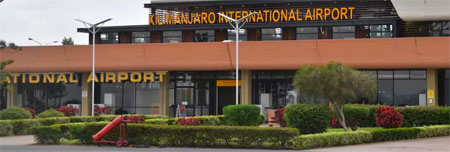
Day 1 – Arrivals
Your safari begins the moment you exit the Kilimanjaro International Airport (JRO) and are greeted by your guide(s). They will help you with your luggage, and will take you to your first night’s accommodation at a beautifully appointed safari lodge in Arusha.
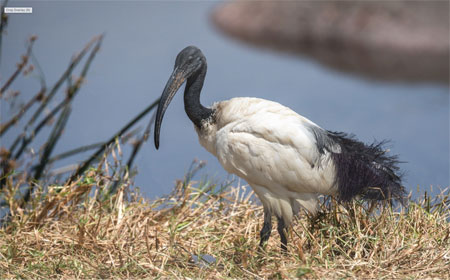
Day 2 – Lake Manyara National Park
Lake Manyara National Park is a great place to let the fun begin! In fact, the fun may even start before you enter the park if you encounter the HUGE troop of baboons that sort of “own” the stretch of highway leading to the park. We think of them as the official greeters for LMNP!
Once inside LMNP you’ll encounter a wide variety of animals which thrive in the short savannah grasslands and shrubs which dominate the landscape. Keep an eye out for leopards, elephants, wildebeest, cape buffalo and giraffes. And continually scan the trees for lions, as LMNP’s nickname is “Home of the Tree-climbing Lions.”
Not surprisingly, LMNP is a birding paradise as well! It is home to approximately 400 bird species that thrive in the variety of habitats inside this park. It’s fun to keep track of how many you spot during your time in this park! Your guide(s) can help you identify any of them you are unfamiliar with.
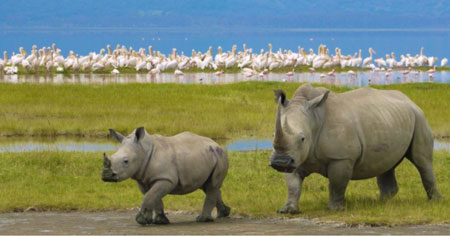
Day 3 – Ngorongoro Highlands & Crater Day
It is worth the early wake up to be one of the first groups to reach the crater floor on “Crater Day!” The primary goal of this day is to be on the lookout for the endangered Black Rhino. This will be your best shot at finding this element of the Big Five!
Although Tanzania has many wilderness and wildlife show pieces, this one is particularly difficult to put into words. With remarkable views from the ridge above, to the real action on the crater floor, the crater embodies a constant stir of wildlife and unspoiled scenes to keep you engrossed.
One of our past guests described Ngorongoro as “Where Heaven Meets Earth!” Another said it was like “A mixture of Narnia and Seuss, with just a dash of Jurassic Park!” However YOU describe it, it is a MUST-SEE on any Tanzanian safari!
Millions of years ago this enormous volcano collapse and formed this massive CALDERA that we mistakenly refer to the “Ngorongoro Crater.” Present day, this caldera is now an incredible, self-sustaining ecosystem that boasts the highest density of African wildlife on Earth, and a UNESCO World Heritage site to boot!
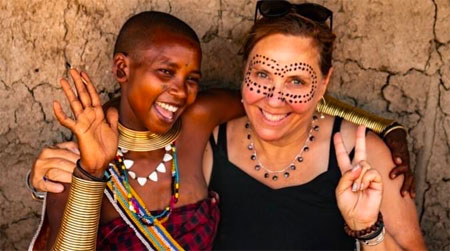
Days 4-5 – Tribal Interactions – Great Rift Valley
Your guide(s) will take you over the river and through the woods and on into the Great Rift Valley in order to facilitate your interactions with three different tribal families tribes that live in this rural and agricultural region of Tanzania.
You will get the chance to meet the incredible “blacksmith family” of the Datoga tribe. These folks adeptly turn scrap metal into useful weapons and really beautiful and fun jewelry!
The Datoga tribe’s greeting is, “Say you” (hello, essentially).
The blacksmith family is delightful, and they will astonish you with what they can make from a what looks like a pile of junk! You can participate in a good bit of the process, or just sit back and watch the magic!
While in this area, you’ll also pay a visit to the “farming family” of the Datoga tribe. This is a family comprised of a 93+ year old patriarch (pictured below), his 10 wives, 50+ kids, and 100+ grandkids. This man is absolutely brilliant to interact with… very funny, genuine, and still sharp as a tack!
The women of the farming family do almost everything in the tribe… farming, ranching, harvesting, grinding, cooking, bearing and raising the kids, beadwork, and dealing with the very few tourists who are lucky enough to get to meet them in person.
As a matter of course, it is always polite to ask if you can take photos of them and their children. They will say YES! They love to have their pictures taken, and will then swarm around you to see the pictures on your phone screen or the back of your camera!
Feel free to ask them questions about the plural marriage situation, what a day in their life is like, what happens when one of them has a new baby, etc. The interpreter will help you communicate with one another… and they may even start asking you about your lives too!
Such fun!
The THIRD group you will meet is perhaps the most special of all. This is beyond your typical Bucket List-level stuff! They are known as the Hadzabe Tribe (or Hadza for short). They are the last hunter/gatherer tribe in all of Africa.
Experts say there are only about 1000 of them left at this point, and that they will likely die out completely in the next couple of decades, as the women are being persuaded to leave the tribe and marry into the Massai tribe for a better lifestyle.
“Say you” will NOT work with these folks. They speak the language that has a lot of clicks and pops in it… so ask your interpreter to help you learn to say “”Hello” and “Thank you” in Hadza!
The Hadza hunt nearly every day, just to keep their families fed. They will hunt almost anything from mice and birds to huge antelope… and everything in between… and they waste NOTHING! Honey is about 15% of their diet, so be sure to ask your interpreter to explain how they find and collect honey, as it is a fascinating story.
Members of the tribe (via your interpreter) will tell you all about their weapons, hunting techniques and traditional ways. They may let you shoot their bows and arrows, or perhaps you’ll be invited to help them make fire! You never know what you’ll get to see or do when you visit these fascinating people!

Days 6-8 — Southern Serengeti (Ndutu)
Your next adventure will take place on the Ndutu Plains in the Southern Serengeti. This area was made famous by documentary and cinematic filmmakers, and by researchers such as Jane Goodall.
The best months to visit the Ndutu Region are from December (when the Great Migration herds start to arrive from the north) until April when the millions of wildebeest, zebra and gazelle have begun their next march northwards once again.
In the early months of the year – with a peak in February – the wildebeest herds are calving on the verdant grassy plains (upwards of 8,000 baby animals are born in this region each day during calving season), which, in turn, also attracts the attention of cheetahs, lions and hyenas. All six of the big cat species can be found in the area all year – lion, leopard, cheetah, caracal, serval and African wildcat.
Lake Ndutu and Lake Masek form shallow basins where water accumulates from the nearby highlands. The water in both lakes are extremely saline… too saline for human consumption. Lake Ndutu comes alive with animals during the migration because it is surrounded by the dense woodlands and short-grass plains, which provide ample cover and food.

Days 9-11 – Olduvai Gorge & Central Serengeti National Park
During the transition to the Central Serengeti, you’ll stop at the OLDUVAI GORGE for a “lunch-and-learn” session and a visit to their well-curated museum. This gorge is known around the world as “The Cradle of Mankind,” as the oldest human footprints were famously discovered there by Mary Leakey in 1959.
The site remains an active archeological excavation site, with universities, museums, and other research institutions sending teams of scientists there each year to continue the exploration. It is a fascinating place to spend a couple of hours and realize that every single person on the planet can trace their lineage to this very spot on Earth.
NEXT STOP… Serengeti National Park!!
The majestic and famous Serengeti is the thing that dreams are made of! Giant granite kopjes (pr. co-pees) seemingly pop up out of nowhere, dotting the landscape like islands in a sea of breeze-blown grasses.
The park has a well-earned reputation for reliable and unforgettable wildlife encounters which, at times, seem to be around every bend in the road! You should have no problem spotting elephants, giraffes, zebras, antelopes of every variety, hippos, and more! Your guide(s) will help you spot the big cats, as those are usually much harder to locate. And the birds in the parks of Tanzania are nothing short of mind blowing in terms of volume, variety, and beauty!
And, once again, the birds play a huge role in the beauty and vibrancy of the park. They are nothing short of mind blowing, both in volume and beauty!
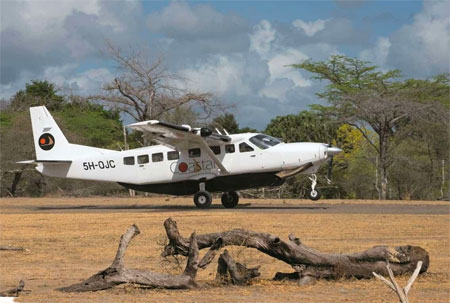
Day 12 – Bush Flight to Arusha / Lunch / Day Use / Departures
There’s time for just one last mini-game drive on the way to the airstrip.
Saying goodbye to your safari guide(s) at the end of an incredible journey is bittersweet. They have shared their knowledge, expertise and passion for Africa’s wilderness with you, making your safari experience safe, comfortable, and unforgettable.
These guys were complete strangers just 10 short days ago, but now they are your forever friends.
Be sure to look out the windows as your plane lifts off from the tiny dirt runway, and silently say your thanks and goodbyes to the mighty Serengeti too!
Upon landing back in Arusha, new guide(s) will meet you and escort you through your final day in Tanzania. Time permitting, they may offer a lunch and shopping opportunity, and/or a few hours in day-use rooms so that you can repack, refresh, and prepare for your long flights home again.
Either way, the goal of this day is to ensure you get to the airport in plenty of time to negotiate the check in and security process, and then relax onto your homeward flight… with your heart and mind full of the wonderful memories from your time in Tanzania!
Once home, we truly hope that you’ll tell your friends about the epic adventure and fun you had with Wanderful Tanzania!
Referrals are the biggest compliment we could hope for!
If you think that being on a safari means you’ll be roughing it… THINK AGAIN!!
Our small size really works to our advantage (and YOURS)! Because we are not beholden to one brand or chain of camps and lodges, we take great care in selecting the accommodations that are just right for each of our safaris. Your safety and comfort are always our top priority!
Day 1 – Arusha – Planet Lodge
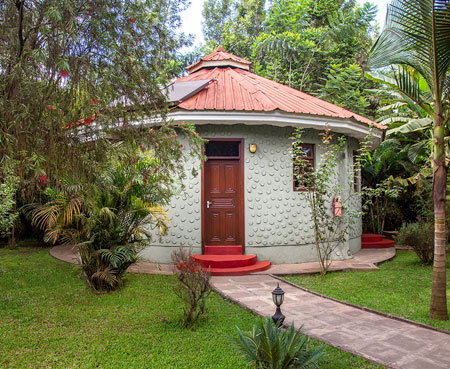 The Planet Lodge in Arusha is where you’ll spend your first night in Tanzania. This sweet little lodge is quietly tucked away from the bustling main streets of Arusha. The casita-style accommodations are spread out amongst the beautifully manicured lawns and gardens, and guests can enjoy a meal or drink at their onsite restaurant and bar in the man building.
The Planet Lodge in Arusha is where you’ll spend your first night in Tanzania. This sweet little lodge is quietly tucked away from the bustling main streets of Arusha. The casita-style accommodations are spread out amongst the beautifully manicured lawns and gardens, and guests can enjoy a meal or drink at their onsite restaurant and bar in the man building.
After your long flights, you can rest assured that a nice hot shower and comfortable bed await.
Days 2-3 – Maramboi Tented Lodge
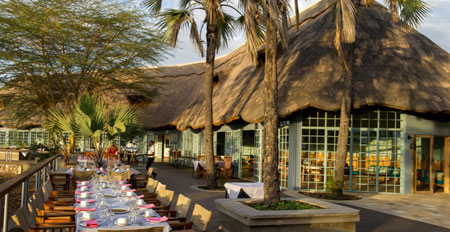 During your time in the Tarangire area, you’ll be staying at the Maramboi Tented Lodge. Each night you can enjoy a free, poolside happy hour as you watch a variety of animals grazing on the grasslands all around you.
During your time in the Tarangire area, you’ll be staying at the Maramboi Tented Lodge. Each night you can enjoy a free, poolside happy hour as you watch a variety of animals grazing on the grasslands all around you.
Weather permitting, dining here is outdoors.
From the pool deck, you’ll gaze out over Lake Manyara and watch the sun set behind the Great Rift Valley range in the distance. Check with the front desk to see if one of the Masaai guides will be leading the evening walk to the lake.
Day 4 – Lake Eyasi Safari Lodge
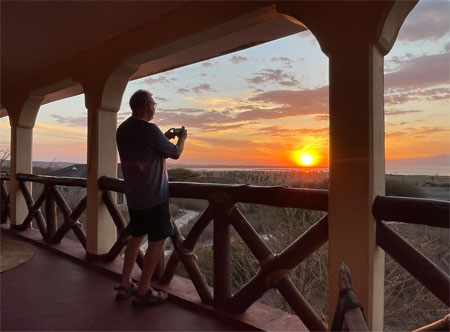 This very remote lodge has amazing views to the east, over Lake Eyasi and the Great Rift Valley… and has one of the best sunset views in all of Africa! It just happens to be pretty much the only option for a place to stay in order to interact with both the Datoga and Hadzabe tribes. A bit off the beaten typical safari path, but we promise you the experiences you’ll have in this region are worth the extra effort! You are going to get access to tribes that 98% of the safari companies out there don’t have access to. Be sure to soak in this part of the journey.
This very remote lodge has amazing views to the east, over Lake Eyasi and the Great Rift Valley… and has one of the best sunset views in all of Africa! It just happens to be pretty much the only option for a place to stay in order to interact with both the Datoga and Hadzabe tribes. A bit off the beaten typical safari path, but we promise you the experiences you’ll have in this region are worth the extra effort! You are going to get access to tribes that 98% of the safari companies out there don’t have access to. Be sure to soak in this part of the journey.
Day 5 – Ngorongoro Highlands – Safari Lodge
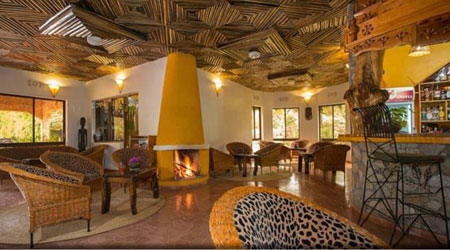 Following today’s game drive you’ll check into one of the spectacular lodges that the Karatu region is known for. Delicious meals, comfortable beds, and vibrant lounges will have you make you feel at home while in the lush surroundings of the Ngorongoro highlands.
Following today’s game drive you’ll check into one of the spectacular lodges that the Karatu region is known for. Delicious meals, comfortable beds, and vibrant lounges will have you make you feel at home while in the lush surroundings of the Ngorongoro highlands.
Feel free to get out and stretch your legs on the paths and walkways that meander around these properties.
Days 6-8 – Ndutu Plains (Southern Serengeti) – Tented Camp
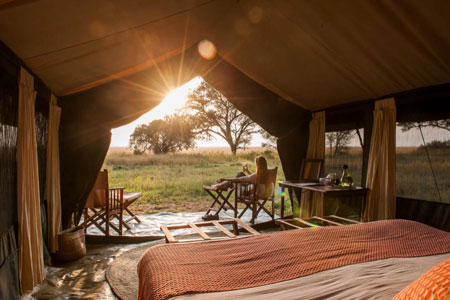 Wanderful Tanzania selects only well-located and well-run tented camps that can truly deliver an amazing experience to our guests. Nothing beats a hot shower and a spacious, comfy place to relax after a long day of game driving, bumpy roads, and close-up wildlife encounters. After you’ve rested a bit, wander over to the campfire for an evening drink and to compare notes with others about that day’s adventures…or just sit quietly and reflect on your own amazing day.
Wanderful Tanzania selects only well-located and well-run tented camps that can truly deliver an amazing experience to our guests. Nothing beats a hot shower and a spacious, comfy place to relax after a long day of game driving, bumpy roads, and close-up wildlife encounters. After you’ve rested a bit, wander over to the campfire for an evening drink and to compare notes with others about that day’s adventures…or just sit quietly and reflect on your own amazing day.
Days 9-11 – Central Serengeti National Park – Tented Camp
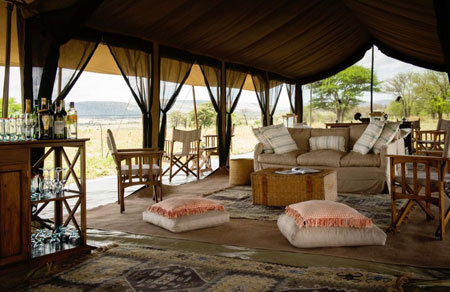 During your time in the Central Serengeti, you’ll be staying at one of the incredible tented camps in that region. While each camp has a different vibe, they are little havens of comfort and relaxation smack-dab in the middle of the bush! With all the amenities you could desire, they are truly a wonderful home away from home!
During your time in the Central Serengeti, you’ll be staying at one of the incredible tented camps in that region. While each camp has a different vibe, they are little havens of comfort and relaxation smack-dab in the middle of the bush! With all the amenities you could desire, they are truly a wonderful home away from home!
The sunrises and sunsets in the Serengeti are reliably breathtaking, as is the beauty of this wild and precious place. You can’t help but feel the tensions of the first world melt away, so be sure to stay present and soak in every detail of your safari. So once back at camp after a long day of game viewing, take a nice hot shower, get a bit of rest, and then head over to the campfire to have a drink before dinner and to watch one of those aforementioned sunsets. We hope these are the moments that give you pause, and let you simply relax and reflect on where you are, and the gifts from another day on safari.
